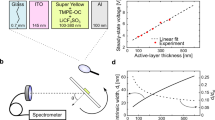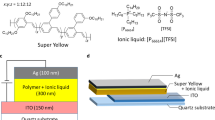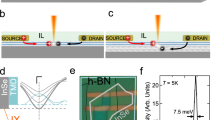Abstract
The interplay between ionic and electronic charge carriers in mixed conductors offers rich physics and unique device potential. In light-emitting electrochemical cells (LEECs), for example, the redistribution of ions assists the injection of electronic carriers and leads to efficient light emission. The mechanism of operation of LEECs has been controversial, as there is no consensus regarding the distribution of electric field in these devices. Here, we probe the operation of LEECs using electric force microscopy on planar devices. We show that obtaining the appropriate boundary conditions is essential for capturing the underlying device physics. A patterning scheme that avoids overlap between the mixed-conductor layer and the metal electrodes enabled the accurate in situ measurement of the electric-field distribution. The results show that accumulation and depletion of mobile ions near the electrodes create high interfacial electric fields that enhance the injection of electronic carriers.
This is a preview of subscription content, access via your institution
Access options
Subscribe to this journal
Receive 12 print issues and online access
$259.00 per year
only $21.58 per issue
Buy this article
- Purchase on Springer Link
- Instant access to full article PDF
Prices may be subject to local taxes which are calculated during checkout






Similar content being viewed by others
References
Maier, J. Nanoionics: Ion transport and electrochemical storage in confined systems. Nature Mater. 4, 805–815 (2005).
Bruce, P. G. Solid State Electrochemistry (Cambridge Univ. Press, London, 1995).
Maier, J. Electrical sensing of complex gaseous species by making use of acid-base properties. Solid State Ion. 62, 105–111 (1993).
Nilsson, D., Kugler, T., Svensson, P.-O. & Berggren, M. An all-organic sensor–transistor based on a novel electrochemical transducer concept printed electrochemical sensors on paper. Sensors Actuators B 86, 193–197 (2002).
Gustafsson, J. C., Liedberg, B. & Inganäs, O. In situ spectroscopic investigations of electrochromism and ion transport in a poly (3,4-ethylenedioxythiophene) electrode in a solid state electrochemical cell. Solid State Ion. 69, 145–152 (1994).
Hibino, T. et al. A low-operating-temperature solid oxide fuel cell in hydrocarbon-air mixtures. Science 288, 2031–2033 (2000).
Croce, F., Appetecchi, G. B., Persi, L. & Scrosati, B. Nanocomposite polymer electrolytes for lithium batteries. Nature 394, 456–458 (1998).
Gadjourova, Z., Andreev, Y. G., Tunstall, D. P. & Bruce, P. G. Ionic conductivity in crystalline polymer electrolytes. Nature 412, 520–523 (2001).
Grätzel, M. Photoelectrochemical cells. Nature 414, 338–344 (2001).
Bernards, D. A., Flores-Torres, S., Abruña, H. D. & Malliaras, G. G. Observation of electroluminescence and photovoltaic response in ionic junctions. Science 313, 1416–1419 (2006).
Pei, Q., Yu, G., Zhang, C., Yang, Y. & Heeger, A. J. Polymer light-emitting electrochemical cells. Science 269, 1086–1088 (1995).
Riess, I. & Cahen, D. Analysis of light emitting polymer electrochemical cells. J. Appl. Phys. 82, 3147–3151 (1997).
Smith, D. L. Steady state model for polymer light-emitting electrochemical cells. J. Appl. Phys. 81, 2869–2880 (1997).
Manzanares, J. A., Reiss, H. & Heeger, A. J. Polymer light-emitting electrochemical cells: a theoretical study of junction formation under steady-state conditions. J. Phys. Chem. B 102, 4327–4336 (1998).
deMello, J. C., Tessler, N., Graham, S. C. & Friend, R. H. Ionic space-charge effects in polymer light-emitting diodes. Phys. Rev. B 57, 12951 (1998).
deMello, J. C. Interfacial feedback dynamics in polymer light-emitting electrochemical cells. Phys. Rev. B 66, 235210 (2002).
Gao, J., Heeger, A. J., Campbell, I. H. & Smith, D. L. Direct observation of junction formation in polymer light-emitting electrochemical cells. Phys. Rev. B 59, R2482–R2485 (1999).
Johansson, T., Mammo, W., Andersson, M. R. & Inganas, O. Light-emitting electrochemical cells from oligo(ethylene oxide)-substituted polythiophenes: Evidence for in situ doping. Chem. Mater. 11, 3133–3139 (1999).
deMello, J. C., Halls, J. J. M., Graham, S. C., Tessler, N. & Friend, R. H. Electric field distribution in polymer light-emitting electrochemical cells. Phys. Rev. Lett. 85, 421–424 (2000).
Moderegger, E. Comparison of the internal field distribution in light-emitting diodes and light-emitting electrochemical cells. Adv. Mater. 12, 825–827 (1996).
Edman, L., Summers, M. A., Buratto, S. K. & Heeger, A. J. Polymer light-emitting electrochemical cells: Doping, luminescence, and mobility. Phys. Rev. B 70, 115212 (2004).
Dick, D. J., Heeger, A. J., Yang, Y. & Pei, Q. B. Imaging the structure of the p-n junction in polymer light-emitting electrochemical cells. Adv. Mater. 8, 985–987 (1996).
Gao, J. & Dane, J. Planar polymer light-emitting electrochemical cells with extremely large interelectrode spacing. Appl. Phys. Lett. 83, 3027–3029 (2003).
Gao, J. & Dane, J. Visualization of electrochemical doping and light-emitting junction formation in conjugated polymer films. Appl. Phys. Lett. 84, 2778–2780 (2003).
Robinson, N. D., Shin, J.-H., Berggren, M. & Edman, L. Doping front propagation in light-emitting electrochemical cells. Phys. Rev. B 74, 155210 (2006).
Mauthner, G. et al. Elimination of defect-induced color instabilities in polymer light-emitting devices. J. Appl. Phys. 97, 063508 (2005).
Pachler, P., Wenzl, F. P., Scherf, U. & Leising, G. The efficiency of light-emitting electrochemical cells. J. Phys. Chem. B 109, 6020–6024 (2005).
Pachler, P., Wenzl, F. P., Scherf, U. & Leising, G. The impact of high bias voltages on the luminance characteristics of light-emitting electrochemical cells. Solid State Ion. 176, 1793–1796 (2005).
Handy, E. S., Pal, A. J. & Rubner, M. F. Solid-state light-emitting devices based on the tris-chelated ruthenium(II) complex. 2. tris(bipyridyl)ruthenium(II) as a high-brightness emitter. J. Am. Chem. Soc. 121, 3525–3528 (1999).
Gao, F. G. & Bard, A. J. Solid-state organic light-emitting diodes based on tris(2,2′-bipyridine)ruthenium(II) complexes. J. Am. Chem. Soc. 122, 7426–7427 (2000).
Rudmann, H. & Rubner, M. F. Single layer light-emitting devices with high efficiency and long lifetime based on tris(2,2′ bipyridyl) ruthenium(II) hexafluorophosphate. J. Appl. Phys. 90, 4338–4345 (2001).
Buda, M., Kalyuzhny, G. & Bard, A. J. Thin-film solid-state electroluminescent devices based on tris(2,2′-bipyridine) ruthenium(II) complexes. J. Am. Chem. Soc. 124, 6090–6098 (2002).
Bernhard, S., Gao, X., Malliaras, G. G. & Abruña, H. D. Efficient electroluminescent devices based on a chelated osmium(II) complex. Adv. Mater. 14, 433–436 (2002).
Bernhard, S. et al. Electroluminescence in ruthenium(II) complexes. J. Am. Chem. Soc. 124, 13624–13628 (2002).
Slinker, J. et al. Solid-state electroluminescent devices based on transition metal complexes. Chem. Commun. 2392–2399 (2003).
Rudmann, H., Shimada, S. & Rubner, M. F. Operational mechanism of light-emitting devices based on Ru(II) complexes: Evidence for electrochemical junction formation. J. Appl. Phys. 94, 115–122 (2003).
Gorodetsky, A. A. et al. Contact issues in electroluminescent devices from ruthenium complexes. Appl. Phys. Lett. 84, 807–809 (2004).
Bernards, D. A. et al. Organic light-emitting devices with laminated top contacts. Appl. Phys. Lett. 84, 3675–3677 (2004).
Bernards, D. A., Slinker, J. D., Malliaras, G. G., Flores-Torres, S. & Abruña, H. D. Cascaded light-emitting devices based on a ruthenium complex. Appl. Phys. Lett. 84, 4980–4982 (2004).
Bolink, H. J., Cappelli, L., Coronado, E., Grätzel, M. & Nazeeruddin, M. K. Efficient and stable solid-state light-emitting electrochemical cell using tris(4,7-diphenyl-1,10-phenanthroline)ruthenium(II) hexafluorophosphate. J. Am. Chem. Soc. 128, 46–47 (2006).
Slinker, J. D. et al. Direct 120 V, 60 Hz operation of an organic light emitting device. J. Appl. Phys. 99, 074502 (2006).
Su, H.-C., Wu, C.-C., Fang, F.-C. & Wong, K.-T. Efficient solid-state host-guest light-emitting electrochemical cells based on cationic transition metal complexes. Appl. Phys. Lett. 89, 261118 (2006).
Moran-Mirabal, J. M. et al. Electroluminescent electrospun nanofibers. Nano Lett. 7, 458–463 (2007).
Slinker, J. D. et al. Electroluminescent devices from ionic transition metal complexes. J. Mater. Chem. (doi:10.1039/b704017b).
Silveira, W. R. & Marohn, J. A. Microscopic view of charge injection in an organic semiconductor. Phys. Rev. Lett. 93, 116104 (2004).
Silveira, W. R., Muller, E. M., Ng, T.-N., Dunlap, D. H. & Marohn, J. A. in Scanning Probe Microscopy: Electrical and Electromechanical Phenomena at the Nanoscale Vol. II (eds Kalinin, S. V. & Gruverman, A.) 788–830 (Springer, New York, 2007).
DeFranco, J. A., Schmidt, B. S., Lipson, M. & Malliaras, G. G. Photolithographic patterning of organic materials. Org. Elect. 7, 22–28 (2006).
Ilic, B. & Craighead, H. G. Topographical patterning of chemically sensitive biological materials using a polymer based dry lift-off. Biomed. Microdev. 2, 317–322 (2000).
Malliaras, G. G. & Scott, J. C. The roles of injection and mobility in organic light emitting diodes. J. Appl. Phys. 83, 5399–5403 (1998).
Scott, J. C. & Malliaras, G. G. Charge injection and recombination at the metal-organic interface. Chem. Phys. Lett. 299, 115–119 (1999).
Acknowledgements
This work was supported by the National Science Foundation, the Center for NanoScale Systems and the New York State Office of Science, Technology and Academic Research (NYSTAR), and made possible by the use of the Cornell NanoScale Facility. J.D.S. was supported by a National Science Foundation Graduate Research Fellowship. Thanks are due to J. Blakely and D. Cahen for fruitful discussions.
Author information
Authors and Affiliations
Corresponding author
Rights and permissions
About this article
Cite this article
Slinker, J., DeFranco, J., Jaquith, M. et al. Direct measurement of the electric-field distribution in a light-emitting electrochemical cell. Nature Mater 6, 894–899 (2007). https://doi.org/10.1038/nmat2021
Received:
Accepted:
Published:
Issue Date:
DOI: https://doi.org/10.1038/nmat2021
This article is cited by
-
Visualizing electroluminescence process in light-emitting electrochemical cells
Nature Communications (2023)
-
Organic mixed ionic–electronic conductors
Nature Materials (2020)
-
An ultra wideband-high spatial resolution-compact electric field sensor based on Lab-on-Fiber technology
Scientific Reports (2019)
-
Design rules for light-emitting electrochemical cells delivering bright luminance at 27.5 percent external quantum efficiency
Nature Communications (2017)
-
Consolidation of the optoelectronic properties of CH3NH3PbBr3 perovskite single crystals
Nature Communications (2017)



